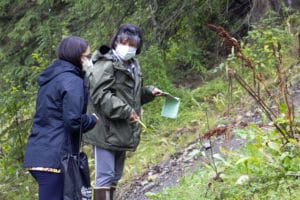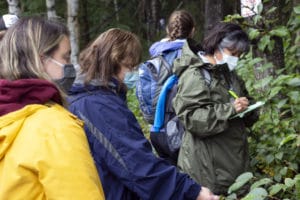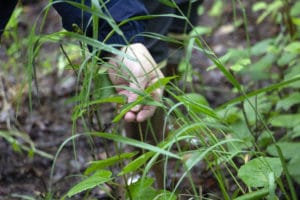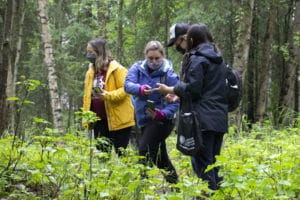 The plants we pass on the way to class were here long before the university. A recent course called Alaska Native Plants and Traditional Uses specifically explored the broad range of benefits that Southcentral Alaska plants – including those on APU’s campus – provide for Alaska Native people.
The plants we pass on the way to class were here long before the university. A recent course called Alaska Native Plants and Traditional Uses specifically explored the broad range of benefits that Southcentral Alaska plants – including those on APU’s campus – provide for Alaska Native people.
The Block course is offered in partnership with Alaska Native Tribal Health Consortium (ANTHC), with course instructors from ANTHC’s Wellness and Prevention department, which promotes holistic wellness through culturally responsive prevention services. Those themes carry into the class at APU.
 Held over two weekends, Alaska Native Plants and Traditional Uses is a highly interactive one-credit course that shares Indigenous plant knowledge with students interested in holistic health.
Held over two weekends, Alaska Native Plants and Traditional Uses is a highly interactive one-credit course that shares Indigenous plant knowledge with students interested in holistic health.
“The first weekend is really setting the foundation for what it means to harvest and use Alaska Native plants from a traditional perspective,” explained Dana Diehl, a co-instructor from ANTHC. Elder mentors join the class to discuss plants as food and medicine as well as ethical harvesting while gathering. Students are encouraged to build a relationship with the land and adopt a mindset of mutual benefit with plants.
“There’s a deep spiritual meaning in every activity that takes place when you’re harvesting traditional plants and foods,” said Marcia Anderson, a co-instructor for the course. “It’s a reciprocal relationship; they take care of us, we take care of them.”
 The course focuses on 20 species common to Southcentral Alaska, each with varying medicinal and nutritional roles. Through discussion, field walks, and conversations with Elders, students learn plant identification techniques, and also hear stories and anecdotes about how each plant can be used for food and medicine. During the course, they learn to create healing salves, food recipes and teas, using plants collected along campus trails.
The course focuses on 20 species common to Southcentral Alaska, each with varying medicinal and nutritional roles. Through discussion, field walks, and conversations with Elders, students learn plant identification techniques, and also hear stories and anecdotes about how each plant can be used for food and medicine. During the course, they learn to create healing salves, food recipes and teas, using plants collected along campus trails.
Plants are essential to holistic health and provide far more than just nutrition. Harvesting plants encourages wellness through physical activity, as well as spiritual and cultural connections.
“Participating in and sharing the harvest is integral for social and education systems in Alaska Native communities,” Marcia said. Plant use can benefit physical, mental, emotional, and spiritual health.
 Collaboration is also an important facet of the class. Students and instructors share stories and learn from each other. “That collaborative learning style is really important,” added Marcia. “Everyone has a different relationship with plants. Everyone feels like they can contribute.”
Collaboration is also an important facet of the class. Students and instructors share stories and learn from each other. “That collaborative learning style is really important,” added Marcia. “Everyone has a different relationship with plants. Everyone feels like they can contribute.”
While the class is full of interaction and activity, two weekends isn’t enough to share generations of knowledge. The course is simply intended as an introduction to Alaska Native plants and their uses.
 “The class is really to spark continued learning and to sustain knowledge of traditional plants and their food and medicine purposes,” Dana said.
“The class is really to spark continued learning and to sustain knowledge of traditional plants and their food and medicine purposes,” Dana said.
OS 105: Alaska Native Plants and Traditional Uses is offered as a Block course in the Fall. For ANTHC programs on plant uses, visit anthc.org/wellness.
